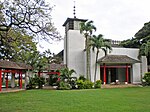Punahou School
1841 establishments in HawaiiChristian schools in HawaiiEducational institutions established in 1841Historic American Buildings Survey in HawaiiHistoric districts on the National Register of Historic Places in Hawaii ... and 7 more
NRHP infobox with nocatNational Register of Historic Places in HonoluluPreparatory schools in HawaiiPrivate K-12 schools in HonoluluSchool buildings on the National Register of Historic Places in HawaiiSchools founded by missionariesUse mdy dates from June 2021

Punahou School (known as Oahu College until 1934) is a private, co-educational, college preparatory school in Honolulu, Hawaii. More than 3,700 students attend the school from kindergarten through 12th grade. Protestant missionaries established Punahou in 1841.In 2006, it was ranked the greenest school in America. In 2017, Punahou's sports program was ranked second nationally in the MaxPreps Cup standings.Punahou's student body is diverse, with student selection based on both academic and non-academic considerations.
Excerpt from the Wikipedia article Punahou School (License: CC BY-SA 3.0, Authors, Images).Punahou School
Chamberlain Drive, Honolulu Makiki
Geographical coordinates (GPS) Address Nearby Places Show on map
Geographical coordinates (GPS)
| Latitude | Longitude |
|---|---|
| N 21.302777777778 ° | E -157.83 ° |
Address
Dillingham Hall
Chamberlain Drive
96822 Honolulu, Makiki
Hawaii, United States
Open on Google Maps








